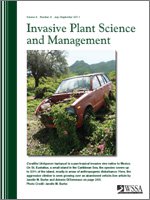Preinvasion baseline data on entire communities are absent for most taxa in most places, and this limits our ability to connect long-term ecological changes to particular invasive species or invasion events. We obtained data on forest understory composition from 94 stands in the 1950s and again the 2000s. We recorded within-stand frequency of occurrence for garlic mustard, European buckthorn, and Bell's honeysuckle and identified changes in native plant species density in 20, 1-m2 quadrats in invaded and noninvaded stands. All three invasive species were absent from all study sites 50 yr ago, yet at least one was present in 77.7% of the stands by the 2000s. All three species were present in 14.9% of the stands. Garlic mustard and European buckthorn were found at 47.9% of resurveyed sites, and Bell's honeysuckle was found in 40.4% of resurveyed sites. Native understory plant species density declined an average of 23.1% during the past 50 yr. Declines were not significantly different in stands with or without invasive plants. The absence of a measurable effect by invasive plant presence or frequency could be due to invasive plants being too few to have a measurable effect at the plot scale, species density being an insensitive response variable, time lags between invasions and effects, or regional factors like development pressure and fire suppression driving density declines in both invasives and native species.
Nomenclature: Bell's honeysuckle; Lonicera × bella Zabel (morrowii × tatarica); European buckthorn; Rhamnus cathartica L.; garlic mustard; Alliaria petiolata (Beib.) Cavara & Grande.
Interpretive Summary: Garlic mustard, European buckthorn, and Bell's honeysuckle are invasive plants of Eurasian origin that have established and spread in North America. All three species invade forests, but we know surprisingly little about how the richness or diversity of plant communities responds to that invasion. The absence of preinvasion plant community data from most stands contributes to our limited understanding. In this study, we acquired high-quality plant community data that was obtained in the 1950s from 94 forest stands in southern Wisconsin. None had garlic mustard, European buckthorn, or Bell's honeysuckle. We revisited those stands in the 2000s and replicated the survey methods. We were able to determine what fraction of the stands was invaded since the initial survey. Garlic mustard and European buckthorn were found in 48% of all stands, whereas Bell's honeysuckle was found at 40%. Across all sites, plant species richness at the plot scale declined 26%. Species richness declines did not differ between sites with and those without invasive plants, even when the frequency of the invasive plants was taken into account. The existence of baseline data from both invaded and uninvaded stands prevented us from incorrectly attributing species richness declines to invasive species effects. We caution readers against generalizing these findings beyond southern Wisconsin, and we do not claim that these invasive species have no effect on native plant communities because this was a correlative study. We instead argue that the combined effects of fire suppression and landscape fragmentation have contributed to declines in native species richness. Once established, however, garlic mustard, European buckthorn, and Bell's honeysuckle create conditions that facilitate their own persistence.





